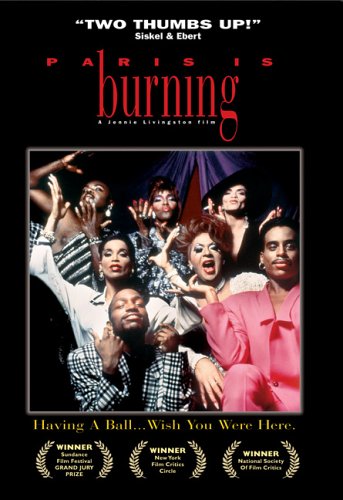
Image Credit: Wikipedia
I was initially going to begin this rumination with the pretty dull introductory phrase “In Jennie Livingston's 1990 documentary film Paris is Burning,” but before the virtual ink had dried on the virtual page I was struck with pretty massive doubts. In what sense could Paris is Burning really be solely attributed to Jennie Livingston when the movie's energy, its drive and message, clearly came from the lives of the New York City ballroom scene participants Livingston interviewed? So would calling Paris is Burning a collaborative documentary effort solve the issue of artistic attribution? Well, kind of, but that seemed to somewhat cheapen the lived experiences of the ball culture community by reducing them to stylized components in a cinematic production. Calling an interviewee an artist leaves over some troubling remainder, a residue of “real life” that doesn't make it into the credits. Even more troubling was the threat of de-centering Livingston's gaze as the focusing lens of the documentary. If it felt wrong to implicitly give Livingston all the credit for the film, it felt worse to call the piece a purely collective effort when Livingston's preferences, questions, decisions and selections dictate the entire film.
In Bodies that Matter (1993), a work expanding on the notions of gender performativity first laid out thoroughly in Gender Trouble (1990), Judith Butler examines the function of Livingston's (and the camera's) gaze. To set up this examination, Butler quotes bell hooks on Livingston's position in Paris is Burning. hooks argues that Livingston explores the ball culture as “an outsider looking in,” an outsider who does not question her own perspective but assumes the transparent objectivity of her gaze. This assumption proves problematic since it threatens to replicate a structure of white privilege, exposing the spectacle of black bodies in order to “magnanimously” grant ballroom participants their moment of fame. Specifically, hooks says that “since her presence as white woman/lesbian filmmaker is 'absent' from Paris is Burning, it is easy for viewers to imagine that they are watching an ethnographic film documenting the life of black gay 'natives' and not recognize that they are watching a work shaped and formed from a perspective and standpoint specific to Livingston” (hooks qtd. in Butler 92).
Butler, on the other hand, wonders whether or not Livingston's lesbian identity might shift the apparent transparency of her camera. Butler agrees with hooks that the camera is a locus of power, a site of affirmation, and that this power needs to be theorized and methodologically examined instead of taken for granted. According to Butler, “the camera acts as surgical instrument and operation, the vehicle through which the transubstantiation occurs. Livingston thus becomes the one with the power to turn men into women who, then, depend on the power of her gaze to become and remain women” (93). It is interesting to consider how the medium of film participates in the gender construction of the ballroom scene, perhaps enacting, not obscuring, the importance of the witness or viewer to the actual gender performance. Even this angle, or the possibility that some of Livingston's scenes enact unspoken lesbian desire, fails to expound on how “the Livingston perspective” intersects with the lived realities of ballroom contestants in terms of, for example, gender, class, and race. In this documentary on performative identities, the dangers of transgression, the joy of spectacle, and the importance of community, does Livingston's gaze emphasize some aspects at the cost of losing others? Does her perspective distort, and if so, is there even any way to counteract misrepresentation in a cultural study?
Marlon M. Bailey's phenomenal ethnography Butch Queens Up in Pumps (2013) offers an intriguing response to these questions. Even though Bailey's book lacks cinematic presence, he metaphorically puts himself “on camera” with the individuals he discusses, interviews and analyzes by engaging in “co-performative witness,” a technique for bridging the gap between researchers and the subjects she studies. According to Bailey, this technique “requires one to perform and lend one's own body and labor to the process involved in the cultural formation under study, particularly when it involves a struggle for social justice. Performance thereby becomes the vehicle for moving across seemingly disparate social locations and registers of knowledge” (22). Bailey's active participation in the ballroom scene over many years allows him to claim the status of co-performative witness, and this status implicates him in his own interpretations of the community. Of course, Bailey's proximity to the culture he analyzes opens up a new set of questions: does being too close to a “subject” cause a different sort of distortion? Does it suggest that an unfair, “overly appreciative” reading has occurred? Of course, the respective proximity of the researcher to the subject in these distinct methodologies indicates differing end goals. For example, Butler's removed analysis lends itself to an examination of ballroom culture that focuses on the theoretical subject of gender subversion or capitulation while Bailey's intimacy gives his description of “survival and the pursuit of a better quality of life” more emotional impact (54-55). It does, however, seem difficult to argue that a researcher can ever safely erase herself from a cultural study without implying that her gaze or perspective should not be questioned.

Recent comments
2 years 29 weeks ago
2 years 44 weeks ago
2 years 44 weeks ago
2 years 50 weeks ago
3 years 4 weeks ago
3 years 4 weeks ago
3 years 4 weeks ago
3 years 6 weeks ago
3 years 6 weeks ago
3 years 6 weeks ago